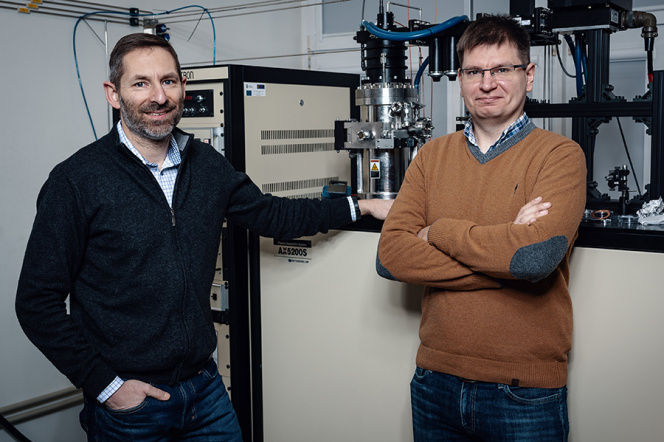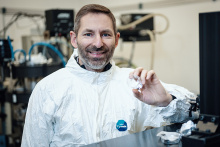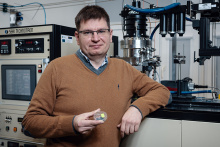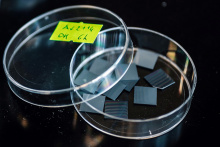Date added: 2021-01-26
The only team of scientists in Poland who create diamond semiconductors

Scientists from the Faculty of Electronics, Telecommunications and Informatics of GUT are engaged in research on synthetic semiconductor diamond (nanocarbon and diamond layers)
Why a diamond?
- With typical metallic conductivity (e.g. graphene) biological interactions often lead to local destruction of biological matter. The question then arises whether, for example, there was no virus or was it destroyed with the system that was supposed to detect it? - says PhD, DSc, Eng. Robert Bogdanowicz, university professor, deputy head of the Metrology and Optoelectronics Department at the GUT ETI Faculty. - That is why the aim is to use semiconductors, such as the diamond we manufacture, to form a specific conductive structure.
The team of prof. Bogdanowicz, which is the only team in Poland dealing with the synthesis of semiconductor diamond structures, maintains contact with teams from the USA, China, Germany, Great Britain, France and Italy and conducts joint experiments with them.
Below we present some of the projects carried out at the Laboratory for the Synthesis of Innovative Materials and Elements (Center for Advanced Technologies) located at FETI, headed by prof. Bogdanowicz.
Diamonds in the fight against Covid-19 and the flu
As part of the iCOVID project, scientists from GUT have been working for several months to create an electronic analytical platform using diamond electrodes to analyze the mechanisms of SARS-CoV-2 virus attacking cells. The platform is to be used not only to research potential new COVID-19 drugs, but also to check which methods effectively inactivate the virus in saliva and nasal swabs.
- The process of binding the virus to the receptors is an important early stage of infection, in which disease can be prevented with appropriately selected new drugs. We have just succeeded in fusing a carbon surface with the ACE2 receptor, the one that is seen as the main route for the virus to enter cells. These are things that no one has ever done before - Prof. Bogdanowicz reports the course of research. - Parallel to the study of the interaction between the ACE2 receptor and the S-type protein, we are conducting research on the interaction of the N protein - that is, one that does not mutate, so it is the same in every virus - with an antibody. We rely on proteins from other viruses, including HSV and flu, bacteria and fungi.
The team of prof. Bogdanowicz cooperates in this area, among others with a research group from the California Institute of Technology, the Institute of Biotechnology and Molecular Medicine in Gdańsk and biotechnologists from the Jagiellonian University.
In parallel, the flu test project is continuing, which uses a diamond biosensor to detect influenza-causing pathogens in the patient's saliva. As prof. Bogdanowicz forecasts, if the technology proves successful on this platform, it will also be possible to profile it in the future for COVID-19.
Diamond electrodes for wastewater treatment
PhD, Eng. Michał Sobaszek is a member of the team of prof. Bogdanowicz and the contractor in the projects, who is currently starting an independent research career. The young scientist deals with solutions from the broadly understood field if environmental protection.
- Semiconductor diamond electrodes conduct electricity and are a good heat conductors, resistant to harsh environmental conditions. They generate radicals that break down organic compounds that cannot be utilized in biological treatment plants or with other techniques. In this way, not only organic compounds, but also viruses and bacteria can be removed with almost 100% efficiency - explains PhD Michał Sobaszek. - We are currently working on solutions for the mineralization of wastewater and leachate from landfills.
As part of the i-CLARE project financed by the EEA and Norway Grants, headed by prof. Bogdanowicz, an intelligent system is to be created to remove harmful pollutants in water, such as drugs, antibiotics, hormones or dioxins, which are present in rainwater and domestic sewage. It will be a small installation using porous diamond electrodes, which will allow the disposal of problematic organic compounds.
- The material looks like a washing-up sponge, but at the same time it is a conductive material and oxidation takes place on it, explains Prof. Bogdanowicz. - We focus on the oxidation of compounds that, according to the European Commission, constitute the greatest problem, and on the processes related to their decomposition.
Scientists from the ETI Faculty collaborate in this project with scientists from the Institute of Biotechnology and Molecular Medicine in Gdańsk (leader) and the Norwegian Institute for Air Research. The industrial partner is SensDX.
Ultrasensitive analytical systems for scientists
Another program implemented from the Norwegian Fund by the Gdańsk team for diamonds is the UPTURN project, which aims to construct a series of devices for ultra-sensitive measurements of electrochemical processes in micro-volumes for use in both industrial and research laboratories.
- There is practically no such ready-made analytical system on the market - emphasizes prof. Bogdanowicz.
GUT's partners in the project are Sintef MinaLab from Norway, the Institute of Physical Chemistry of the Polish Academy of Sciences and the Polish branch of Redox.me AB.
Dr. Eng. Michał Sobaszek (172.31 points) and prof. Robert Bogdanowicz (155 points) achieve the highest publication results at the Faculty of Electronics, Telecommunications and Informatics and are among the highest-scored scientists at Gdańsk University of Technology in relation to the required filling of publication slots.




